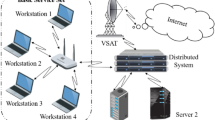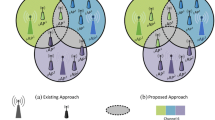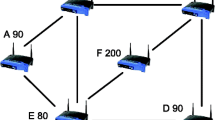Abstract
In Wireless Local Area Networks (WLAN), portable devices such as notebooks, tabs, and smart phones are powered by batteries with limited energy. With the great increase of using such portable devices, energy efficiency becomes one of the most important issues in wireless networks that are based on IEEE 802.11b standard. Although, IEEE 802.11b standard enables devices with limited batteries’ capacity to send and receive more data, it is not suitable for high load networks. In high load networks, Access Point (AP) cannot immediately deliver buffered packets to portable devices which leads to batteries’ drain as devices have to stay in active state for long time. Towards solving this great issue, an energy efficient downlink scheduling algorithm for WLAN is presented in this paper. The proposed scheduler aims to reduce the probability of medium contention and waiting time during the reception of buffered data packets from the AP without affecting the quality of service performance. The presented scheduler proposes a time slotted scheme to enhance the Power Saving Mode of IEEE 802.11b standard. The proposed approach is validated analytically and experimentally. Qualnet network simulator is used for this purpose. Promising results are obtained compared to legacy IEEE 802.11 protocol, and the Shortest Job First scheduler protocol in terms of energy saving, and throughput.


















Similar content being viewed by others
References
Boukerche, A. (2008). Algorithms and protocols for wireless, mobile ad hoc networks. New York: Wiley.
Jiaoa, Y., Hursona, A., & Shirazib, B. (2007). Adaptive application-driven WLAN power management. Pervasive and Mobile Computing Journal,3(3), 255–275.
Ohrtman, F., & Roeder, K. (2003). Wi-Fi handbook: Building 802.11b wireless networks. New York: McGraw-Hill.
LAN/MAN Standards Committee of IEEE Computer Society. (1999). IEEE 802.11b wireless medium access control (MAC) and Physical Layer (PHY) Specification, IEEE, USA.
Agüero, R., Wenning, B. L., Zaki, Y., & Giel, A. T. (2018). Architectures, protocols and algorithms for 5G wireless networks. Mobile Networks and Applications,23(3), 518–520.
Kwonm, D., Kim, S., Park, C., & Jung, C. (2005). Experiments on the energy saving and performance effects of IEEE802.11 power saving mode (PSM). Computer Science, Information Networking. Convergence in Broadband and Mobile Networking,3391, 41–51.
Li, W., Wen, Z., Liu, J., Xiao, S., Wu, X., Cao, Y., et al. (2018). The effective sleep scheduling in wireless opportunistic networks. MATEC Web of Conferences,232(15), 01036.
Akhavan, M. (2006). Study the performance limits of IEEE 802.11 Wireless LANs. MS thesis, Department of Computer Science and Electrical Engineering, Lulea University of Technology, Sweden.
Karl, H. (2003). An overview of energy-efficiency techniques for mobile communication systems. TKN Technical Reports Series. Technische Universitaet.
Stahlbuhk, T., Shrader, B., & Modiano, E. (2019). Learning algorithms for scheduling in wireless networks with unknown channel statistics. Ad Hoc Networks,85, 131–144.
Pollin, S., Mangharam, R., Bougard, B., Van der Perre, L., Moerman, I., Rajkumar, R., et al. (2008). MEERA: Cross-layer methodology for energy efficient resource allocation in wireless networks. IEEE Transactions on Wireless Communications,7(1), 98–109.
Simunic, T. (2005). Power saving techniques for wireless LANs. Proceedings of the Conference on Design, Automation and Test in Europe,3, 277–280.
Simunic, T., Benini, L., Glynn, P., & De Micheli, G. (2000). Dynamic power management for portable systems. In Proceedings of the 6th annual international conference on Mobile computing and networking (pp. 11-19). ACM Publication, Boston, MA, USA.
Zhao, C., Li, Z., & Xiong, Y. (2014). An energy-efficient MAC protocol with delay-bounded downlink traffic scheduling strategy for 802.11 wireless LANs. Journal of Networks,9(7), 1747–1755.
Heo, J., & Park, M. (2017). Shortest job first scheduling for reducing jitter in cyber physical systems. In International conference of embedded systems, cyber-physical systems and applications, ESCS’17 (pp. 23–28).
Jayashree, S., Manoj, B. S., & Murthy, C. S. R. (2004). A battery aware medium access control (BAMAC) protocol for ad hoc wireless networks. In 2004 IEEE 15th international symposium on personal, indoor and mobile radio communications (IEEE Cat. No. 04TH8754) (Vol. 2, pp. 995–999). IEEE.
Park, Y. D., & Suh, Y. J. (2013). An enhanced IEEE 802.11 PSM on Wi-Fi enabled mobile devices. In Proceedings of the KICS winter conference, Yongpyeong, Korea (pp. 221-222).
Gast, M. G. (2005). 802.11 Wireless networks: The definitive guide (2nd ed.). Newton: O’Reilly Media.
Koster, A., & Muñoz, X. (2010). Graphs and algorithms in communication network: Studies in boardband, optical, wireless and ad hoc networks. Berlin: Springer.
Salayma, M., Al-Dubai, A., Romdhani, I., & Nasser, Y. (2017). New dynamic reliable and energy efficient scheduling for wireless body area networks (WBAN). In Proceedings IEEE international conference on communications (ICC) (pp. 1–6).
Brenner, P. (2003). A technical tutorial on The IEEE 802.11 standard. Breezecom wireless communications, Breeze Wireless communication Ltd.
Brown, C. (2006). Endless energy is harvesting’s promise (pp. 1–3). EE Times, No. 1412, P. 1.
Burbank, J., Andrusenko, J., Everett, J. S., & Kasch, W. (2013). Wireless networking: Understanding internetworking challenges. New York: Wiley.
Chandrakasam, A., Sheng, S., & Brodersen, R. W. (1992). Low power CMOS digital design. IEEE Journal of Solid-State Circuits,27(4), 473–483.
Manoj, B., & Murthy, C. (2004). Ad hoc wireless networks: Architectures and protocols. Englewood Cliffs NJ: Prentice Hall.
Vij, V. (2010). Wireless communication. New Delhi: Laxmi Publications.
Kumar, S., Kumar, N., Sheeba, V., & Kashwan, K. (2012). Power efficient dynamic MAC protocol (D-MAC) for wireless sensor networks. Journal of Information and Computational Science,9(7), 1795–1805.
Xie, Y., Luo, X., & Chang, R. X. (2011). Centralizing the power saving mode for 802.11. In T. Aized (Ed.), Infrastructure networks, energy technology and management. New York: InTech publisher.
Bing, B. (2007). Emerging technologies in wireless LANs theory, design, and deployment. Cambridge: Cambridge University Press.
Dam, T., & Langendoen, K. (2003). Energy-efficient MAC: An adaptive energy-efficient MAC protocol for wireless sensor networks. In Proceedings of the 1st international conference on embedded networked sensor systems, Los Angeles, CA, USA (pp. 171–180).
Zheng, R., Hou, J., & Sha L. (2003). Asynchronous wakeup for ad hoc networks. In Proceedings of the 4th ACM international symposium on mobile ad hoc networking and computing, Annapolis, MD, USA (pp. 35–45).
Boudour, G., Teyssie, C., & Mammeri, Z. (2008). Performance analysis of reservation MAC protocols for ad-hoc networks. Wireless and Mobile Networking.,284, 173–186.
Ray, N. K., & Turuk, A. K. (2016). A hybrid energy efficient protocol for mobile ad hoc networks. Journal of Computer Networks and Communications,2016, 11.
He, Y., & Yuan, R. (2009). A novel scheduled power saving mechanism for 802.11 wireless LANs. IEEE Transactions on Mobile Computing,8(10), 1368–1383.
Li, M. (2009). Investigating power consumption in 802.11 WLANs: Measurement, visualization and improvement, MS. thesis, Faculty of Engineering and Science, University of Agder, Norwegian.
Zheng, R., Hou, J. C., & Li, N. (2005). Power Management and Power Control in Wireless Networks. Ad Hoc and Sensor Networks, Wireless Networks and Mobile Computing,2, 1–30.
Zanella, A, & Pellegrini, F. D. (2004). Mathematical analysis of IEEE 802.11 energy efficiency. In Proceedings of wireless personal multimedia communications (WPMC), Abano Terme, Padova, Italy (Vol. 1, pp. 97–105).
Bourawy, A. (2008). Scheduling in IEEE 802.11e networks with quality of service assurance. MS. thesis, Department of Electrical and Computer Engineering Queen’s University Kingston, Ontario, Canada.
Hunn, N. (2010). Essentials of short-range wireless. Cambridge: Cambridge University Press.
The Network Simulator-Qualnet. http://www.scalable-network.com. Accessed 20 Nov 2018.
Jung, E., & Vaidya, H. (2008). Improving IEEE 802.11 power saving mechanism. Wireless Network,14(3), 375–391.
Jung, E., & Vaidya, H. (2002). An energy efficient MAC protocol for wireless LANs. In Proceedings of the 21st IEEE annual joint conference of the IEEE computer and communications societies (INFOCOM), New York, USA (Vol. 3, pp. 1756–1764).
Ibrahim, M. (2005). Conception and analysis of an adaptive backoff algorithm for 802.11 wireless LANs. Internship Report, Master RSD University of Nice Sophia-Antipolis, INRIA Sophia-Antipolis.
Xie, Y. (2007). Energy efficiency in IEEE 802.11 wireless networks. Ph.D. thesis, The Hong Kong Polytechnic University, Hong Kong, China.
Alhatib, I. (2003). Performance analysis of wireless LAN access points. In Licentiate of Technology Thesis, Department of Microelectronics and Information Technology, Royal Institute of Technology, Stockholm, Sweden.
Garcia, A., Serranoa, P., Banchsa, A., & Hollickc, M. (2012). Balancing energy efficiency and throughput fairness in IEEE802.11 WLANs. Pervasive and Mobile Computing Journal,8, 631–645.
Okamoto, G., & Nicholson, W. (2002). Smart antenna systems and wireless LANs. The International Series in Engineering and Computer Science,474, 17–57.
Author information
Authors and Affiliations
Corresponding author
Additional information
Publisher's Note
Springer Nature remains neutral with regard to jurisdictional claims in published maps and institutional affiliations.
Rights and permissions
About this article
Cite this article
Hisham, M., Elmogy, A., Sarhan, A. et al. Energy efficient scheduling in local area networks. Wireless Netw 26, 685–698 (2020). https://doi.org/10.1007/s11276-019-02174-5
Published:
Issue Date:
DOI: https://doi.org/10.1007/s11276-019-02174-5




